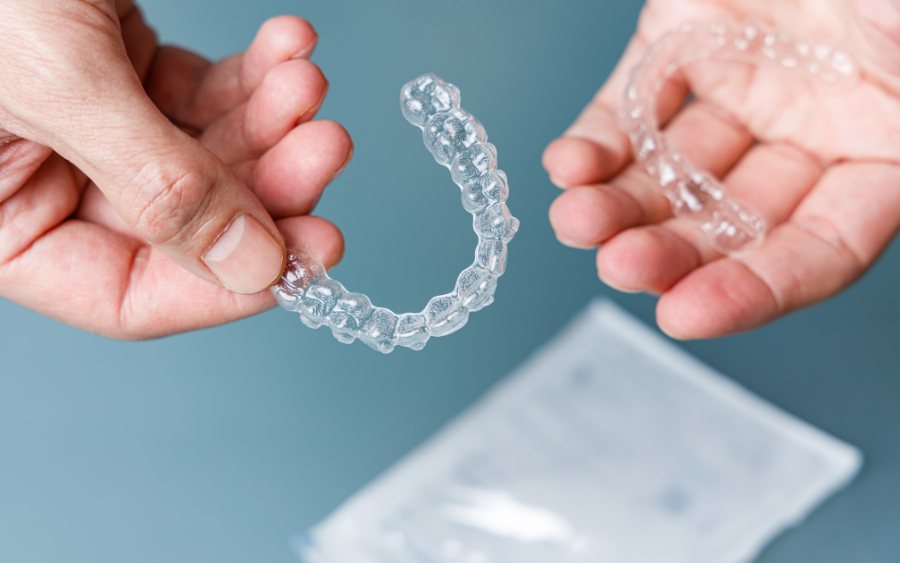
What Can I Clean My Aligners With?
Invisalign and other aligners have become increasingly popular options for achieving straighter teeth. These removable braces provide a more aesthetically pleasing alternative to traditional metal braces. However, keeping aligners clean is crucial to maintain their effectiveness and ensure good oral hygiene. In this article, we will explore the importance of proper aligner cleaning, the potential consequences of neglecting this routine, and various methods for cleaning aligners, including the use of ultrasonic cleaners.
The Importance of Proper Aligner Cleaning
Proper aligner cleaning is essential to maintain oral health and ensure the success of the orthodontic treatment. Wearing aligners for 20-22 hours a day creates an ideal environment for bacteria to thrive, as they trap food particles and plaque against the teeth and aligner surface. Without regular cleaning, this bacterial growth can lead to a host of oral health issues, including bad breath, tooth decay, and gum disease.
Research shows that maintaining oral hygiene during orthodontic treatment is crucial. A study conducted by the American Journal of Orthodontics and Dentofacial Orthopedics found that inadequate oral hygiene practices during orthodontic treatment can significantly increase the risk of white spot lesions and enamel demineralization. Therefore, proper cleaning of aligners is vital to minimize these risks and maintain healthy teeth and gums.
The Importance of Using the Right Products
When it comes to cleaning aligners, it's important to use the right techniques and products. Avoid using toothpaste to clean aligners, as it can be abrasive and cause scratches, making them more prone to bacterial buildup. Instead, opt for gentle, non-abrasive cleaners specifically designed for aligners. These cleaners are effective in removing bacteria and plaque without damaging the aligner material.
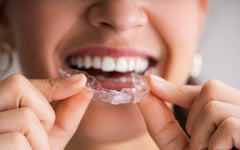
What Happens If I Don't Clean My Aligners?
Neglecting to clean aligners can have detrimental effects on both the aligners themselves and your overall oral health. There were a reported 4 million people globally who started an aligner course within the last year alone, highlighting a large proportion of people who may experience issues if they do not clean their aligners properly.
Discolored & Stained Aligners
Without regular cleaning, aligners can become discolored, stained, and develop an unpleasant odor.
Dental Problems
Additionally, when bacteria and plaque build-up on aligners, they can transfer to your teeth, causing a host of dental problems such as cavities, gum inflammation, and bad breath.
A study published in the Journal of Clinical Orthodontics demonstrated that aligners worn without proper cleaning were more likely to harbor harmful bacteria, including Streptococcus mutans, which is associated with tooth decay. This reinforces the importance of undertaking regular cleaning to maintain your overall oral health.
Furthermore, the accumulation of plaque and bacteria on dirty aligners can also lead to a condition known as "aligner dermatitis." This condition presents as red, inflamed skin around the mouth and can be itchy and uncomfortable. In severe cases, aligner dermatitis can even result in open sores or infections, requiring medical intervention to resolve.
Impact Treatment
Neglecting to clean your aligners can impact the effectiveness of your orthodontic treatment. Dirty aligners may not fit properly, leading to potential delays in your treatment progress. In some cases, the build-up of bacteria on unclean aligners can compromise the structural integrity of the aligners themselves, reducing their lifespan and necessitating premature replacements. With aligner treatments such as Invisalign costing approximately upwards of $3,000, it’s not something you want to risk compromising!
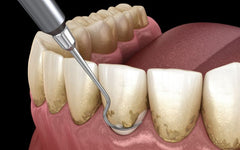
3 Ways to Clean Aligners
To keep your aligners clean and your smile healthy, there are several effective methods you can incorporate into your daily oral hygiene routine:
1. Brushing
Brushing your aligners with a soft-bristled toothbrush and toothpaste is a simple and effective way to remove bacteria and plaque. Use a gentle circular motion to avoid scratching the aligner surface. Rinse them thoroughly before placing them back in your mouth. Avoid using toothpaste with abrasive ingredients, as they can damage the aligners over time.
2. Soaking in Cleaning Solution
Soaking your aligners in a cleaning solution can provide a deeper clean. There are various options available, including specially formulated oral appliance tablets. Follow the manufacturer's instructions and avoid using solutions containing bleach or harsh chemicals, as these can damage the aligners.
3. Ultrasonic Cleaning
Ultrasonic cleaning technology is widely used in dentistry for cleaning dental instruments, dentures, and now aligners. This method utilizes high-frequency sound waves to create microscopic bubbles that implode upon contact with the aligner's surface. This process effectively removes debris and bacteria from hard-to-reach areas.
One popular device for ultrasonic cleaning is the Dental pod. Unlike traditional ultrasonic cleaners, the Dental pod has been specifically engineered for cleaning oral appliances such as aligners. The Dental pod is compact and portable, making it more suitable for home use. It comes equipped with preset cleaning modes and timers, ensuring optimal cleaning without any guesswork.
It's important to note that regardless of the cleaning method you choose, it's crucial to maintain a consistent cleaning routine. Aligners should be cleaned at least twice a day, preferably after meals, to prevent the buildup of bacteria and plaque. Additionally, always remember to handle your aligners with clean hands to avoid transferring any unwanted substances onto them.
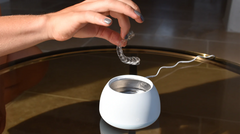
The Benefits of Ultrasonic Cleaning Aligners
Ultrasonic cleaning offers several advantages when it comes to cleaning aligners:
Efficiency
The high-frequency sound waves generated by the ultrasonic cleaner penetrate tiny crevices and remove debris effectively, providing a thorough clean in just 5 minutes with the Dental pod.
Gentleness
Ultrasonic cleaning is gentle on aligners, eliminating the risk of scratching or damaging the surface. This makes it a safe and reliable option for maintaining the quality and transparency of your aligners.
Convenience
The Dental pod is designed to be user-friendly, allowing you to clean your aligners conveniently at home. With presets and timers, it ensures consistent and effective cleaning every time.
Cost-Saving
Investing in the Dental pod may initially seem like an expensive option. However, considering the potential costs of enamel damage, decay treatment, and replacements for extensively damaged aligners, utilizing an ultrasonic cleaner can prove to be a cost-saving measure in the long run.
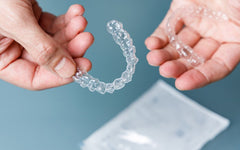
Aligner Cleaning Made Easy with Zima Dental
In summary, proper cleaning of aligners is critical for maintaining oral hygiene and ensuring the success of orthodontic treatment. Neglecting aligner cleaning can lead to a host of dental problems, including tooth decay and gum disease. While brushing and soaking in a cleaning solution are effective methods, ultrasonic cleaning using devices like the Dental pod offers additional benefits such as efficiency, gentleness, convenience, and cost-effectiveness.
At Zima Dental we proudly have a range of aligner cleaning products that use clinical-grade technology to provide the very best oral appliance cleaning solutions to our customers, helping them keep their aligners clean and their smile healthy throughout their orthodontic journey.
If you want to get in touch with the team or have any questions, you can contact us by clicking here.







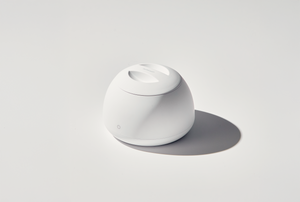
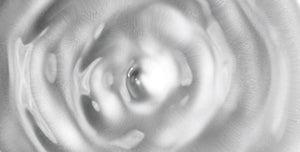

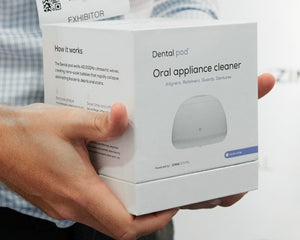




Leave a Comment